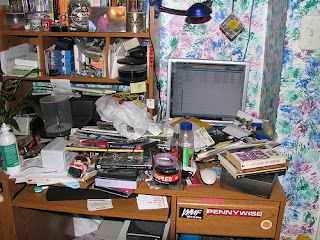I’ve been writing about how every work place is made up of three basic elements:
- Work space: consisting of surfaces, fixtures, furniture and walls
- Storage space: consisting of flexible elements that hold all the necessary tools needed to do the work
- Stimulating space: consisting of non-functional items that foster creativity and inspiration
Let’s apply this concept to a specific work place, that of a creative writer. In addition to my professional organizing business I also write fiction, so my desk and work area have to do double duty. It is a place where I accomplish the dozens of different kinds of tasks involved in running a home-based business, as well as where I sit to create stories out of my imagination. Here's how I’ve approached the second half of that equation by addressing the three elements of my work space, and how I would begin to advise someone else doing the same type of creative work with their space:
Work Space: Being comfortable and functional is key. You probably don’t need tons of clear table space, but an ergonomic computer set up is essential. So, the basic fixtures will be a table or desk with computer, keyboard and mouse (all-in-one-printer and back up hard drive are also useful). If you have a desktop computer, get one with a large screen (I have a 24 incher). If you have a laptop, invest in a separate fully functional keyboard and two-button mouse with a scroll wheel, which are faster and easier to use than a small laptop keyboard and track pad. A comfortable, ergonomic chair is possibly the most important thing. Get one that is highly adjustable and sturdy. I recommend desk chairs without arms, as they tend to get broken and in the way. Easy access bookshelves are useful for elements two and three. Good lighting cannot be overemphasized. You should have overhead lighting as well as localized desk lighting to provide softer light. Think about your computer screen, windows and glare when planning your lighting scheme. Noise canceling headphones are a great way to seal out the sounds of the world when you want to immerse yourself in your work.

Lots of dictionaries
Storage Space: Writers tend to have a lot of reading material, paper, and writing implements, so places to store loose paper as well as binders and notepads are necessary. Books go on bookshelves. Enclosed desk drawers are a great place to keep empty notebooks and office supplies. File cabinets for drafts, articles, story ideas, interviews, contracts, PR, etc. are essential, though if you like to have notes within your reach or line of sight, then a bulletin board or desktop stacking trays are a good additional option. Dictionary, thesaurus, other reference materials also go in the bookcase. Depending on the amount of research for each book or story a separate box for reference material may be needed. You want to keep your current projects closest to your work area. You will likely have tons of information, bookmarks etc. on your computer as well that should be labeled according to project and backed up frequently on an external hard drive.
Stimulating Space: While people vary in terms of how much busyness they want in their line of sight when they write, I think a pleasant color on the walls, some art and a few favorite books within arm’s length is a good start. If you want to get crazy, you can put some inspiring quotes on a bulletin board, put up some photos of loved ones or yourself doing writerly things like going to conferences, book fairs, signings, and with other authors. I like the idea of drawing or finding a picture that represents to you what your project will look like when it’s done—whether it’s a drawing of you accepting an award, selling your book or an idea for what it looks like when it comes off the press, putting your visualizing into tangible, pictorial form can be very powerful.
Over time, we’ll continue exploring how breaking down the three elements of any work space can help give us a lens through which to improve organization and inspire creativity.
Creative commons photo posted to Flickr by General Wesc
Lelah Baker-Rabe is a Los Angeles-based professional organizer. To discuss your organizing needs, call her at 818.269.6671 or email lelah@lelahwithanh.com








